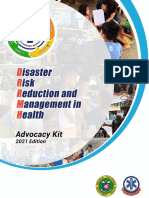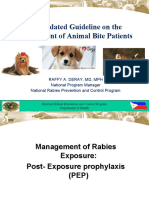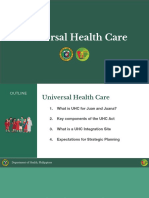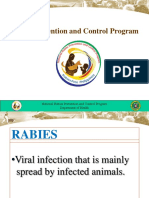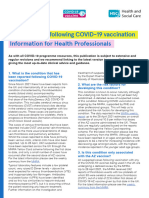Animal Bite Module 2021
Animal Bite Module 2021
Uploaded by
ERMED OFC R2TMCCopyright:
Available Formats
Animal Bite Module 2021
Animal Bite Module 2021
Uploaded by
ERMED OFC R2TMCCopyright
Available Formats
Share this document
Did you find this document useful?
Is this content inappropriate?
Copyright:
Available Formats
Animal Bite Module 2021
Animal Bite Module 2021
Uploaded by
ERMED OFC R2TMCCopyright:
Available Formats
SAN LAZARO HOSPITAL
DEPARTMENT of FAMILY MEDICINE -
INFECTIOUS DISEASES & TROPICAL MEDICINE
GUIDELINES ON
ANIMAL BITE
MANAGEMENT
by Ferdinand S. De Guzman, MD, MHA
FPAFP, FPAFP-TM, FPSVI, FPSMS
COPYRIGHT UPDATED JANUARY 2021
Animal Bite Management Guidelines 2021
OBJECTIVES
1. To inform participants of the updated guidelines and procedures on animal
bite management, in particular rabies prevention.
a. The updated recommendations aim to be more public health-directed and
to propose cost-, dose- and time-sparing regimens as well as the more
prudent use of rabies immunoglobulin (RIG), while still assuring the safety
and clinical effectiveness of these preventive measures
2. To let participants be familiar with local infiltration of wounds and injection
of anti-rabies vaccines in the management of animal bite patients through
video tutorial.
3. To help the Department of Health achieve its goal towards eventual
reduction, if not eradication, of human rabies by information dissemination
and adoption of new treatment guidelines to ensure standardized and
rational management of animal bite patients.
SLH FM-IDTM ABC Management Module 2021[Type text] Page 2
Animal Bite Management Guidelines 2021
TABLE OF CONTENTS
I. Definition of Terms
II. Local Wound Treatment
III. Guide to Tetanus Prophylaxis in Routine Wound Management
IV. Management of Potential Rabies Exposure (Category I)
V. Categories of Rabies Exposure with Corresponding Management
VI. Management of Patients with Category II and III Exposure Where the
Biting Animal Cannot Be Observed or Dies within the 14 Days
Observation Period
VII. Vaccination: General Principles
VIII. Active Immunization
IX. Passive Immunization
X. Adverse Reactions
XI. Recommended Antimicrobials
XII. Post-exposure Prophylaxis
XIII. Post-exposure Treatment under Special Conditions
XIV. Pre-exposure Prophylaxis
XV. Post-Exposure Treatment of Previously Immunized Individuals
XVI. Routine Booster Doses for Previously Immunized Individuals
XVII. Management of Rabies Patients
XVIII. Management of Biting Animal
PRECAUTIONS:
Please check package insert of Purified Chick Embryo Cell Vaccine (PCEC) if
the content of the vial is 7.0 to 7.5 IU, otherwise use 0.2 ml per ID dose
instead of 0.1 ml since potency should be at least 0.5 IU/ID dose.
SLH FM-IDTM ABC Management Module 2021[Type text] Page 3
Animal Bite Management Guidelines 2021
I. DEFINITION OF TERMS
Post-exposure prophylaxis (PEP) – formerly post exposure treatment (PET)
- Refers to anti-rabies treatment administered after an exposure (such as bite, scratch,
lick, etc.) to potentially rabid animals; includes local wound care, administration of rabies
vaccine with or without Rabies Immune Globulin (RIG) depending on category of exposure
Pre-exposure prophylaxis
- Refers to rabies vaccination administered before an exposure to potentially rabid
animals; usually given to those who are at high risk of getting rabies such as veterinarians,
animal handlers, staff in the rabies laboratory, hospitals handling rabies patients and school
children from high risk areas, etc.
Immunocompromised host (as far as response to rabies vaccination is concerned)
- Refers to patients receiving immunosuppressive drugs such as systemic steroids (not
topical or inhaled) and chemotherapeutic drugs for cancer, patients taking chloroquine, AIDS
and HIV infected patients; these are patients expected to have lower immune response to
immunization
Observation period
- Animal observation for 14 days from the time of bite until the appearance of expected
symptoms of rabies
Rabid animal
- Biting animal with clinical manifestation of rabies and/or confirmed laboratory findings
Suspected rabid animal
- Biting animal with a potential to have rabies infection based on unusual behavior, living
condition
like stray dogs, endemicity of rabies in the area and no history of immunization
II. LOCAL WOUND TREATMENT
All bite wounds and scratches should be attended to as soon as possible after the exposure;
thorough washing and flushing of the wound for approximately 10- 15 minutes, with soap or
detergent and copious amounts of water, is required. Where available, an iodine-containing, or
similarly viricidal, topical preparation should be applied to the wound.
Apply alcohol, povidone iodine, or any antiseptic.
SLH FM-IDTM ABC Management Module 2021[Type text] Page 4
Animal Bite Management Guidelines 2021
Suturing of wounds should be avoided at all times since it may inoculate virus deeper into the
wounds. Wounds may be coaptated using sterile adhesive strips. If suturing is unavoidable, it
should be delayed for at least 2 hours after administration of RIG to allow diffusion of the
antibody to occur through the tissues.
Do not apply any ointment, cream or wound dressing to the bite site because it will favor the
growth of bacteria and will occlude drainage of the wound, if any.
Anti-tetanus immunization may be given, if indicated. History of anti-tetanus immunization
should be reviewed. Animal bites are considered tetanus-prone wounds. Completion of the
primary series of tetanus immunization is recommended.
III. GUIDE TO TETANUS PROPHYLAXIS IN ROUTINE WOUND
MANAGEMENT
Type of Injury Vaccination History
Unknown or <3 doses 3 or more Doses
Td* TIG/ATS Td* TIG/ATS
All Animal Bites YES YES NO** NO
*Tdap may be substitutes for Td if the person has received Tdap and is 10 years or older;
DPT may be given for patients <7 years old; TT may be given if Td is not available
- 1 dose each on days 0, 1 month and 6 months
** Yes, if more than 5 years since last dose
Immune individual – has received at least 3 doses of DPT or TT
IV. MANAGEMENT OF POTENTIAL RABIES EXPOSURE
Initiation of post-exposure treatment (PET) should not be delayed for any reason regardless of
interval between exposure and consultation as it increases the risk of rabies and it is associated
with treatment failure.
There are no absolute contraindications to rabies PET. Patients allergic to a specific
vaccine/RIG or its components should be given the alternative vaccine/RIG.
SLH FM-IDTM ABC Management Module 2021[Type text] Page 5
Animal Bite Management Guidelines 2021
The following are 3 categories of exposure to a rabid animal or to an animal suspected to be
rabid, each with corresponding management guideline.
V. CATEGORIES OF RABIES EXPOSURE WITH CORRESPONDING
MANAGEMENT
Category I Management
a) Feeding/touching an animal 1. Wash exposed skin
immediately w/ soap and
b) Licks on intact skin (w/ reliable history and thorough water
physical examination)
2. No vaccine or Rabies
c) Exposure to patient with signs and symptoms of rabies immunoglobulin (RIG)
by sharing of eating or drinking utensils needed
d) Casual contact (talking to, visiting and feeding 3. Pre-exposure vaccination
suspected rabies cases) and routine delivery of health may be considered for high
care to patient with signs and symptoms of rabies risk persons
Category II Management
a) Nibbling of uncovered skin with 1. Wash wound with soap and water.
or without bruising/hematoma
2. Start vaccine immediately:
b) Minor scratches/abrasions
without bleeding
c) Licks on broken skin.
d) All Category II exposures on the
head and neck areas are considered
Cat. III and should be managed as such
Category III Management
a) Single or multiple transdermal 1. Wash wound with soap and water.
bites or scratches with
spontaneous bleeding. 2. Start vaccine and RIG immediately.
SLH FM-IDTM ABC Management Module 2021[Type text] Page 6
Animal Bite Management Guidelines 2021
b) Contamination of mucous
membrane with saliva from licks.
c) Exposure to bat bites or
scratches
b) Exposure to a rabies patient
through bites, contamination of
mucous membranes (eyes,
oral/nasal mucosa, genital/anal
mucous membrane) or open skin
lesions with body fluids through
splattering and mouth-to-mouth
resuscitation
d) Handling of infected carcass or
ingestion of raw infected meat
e) All Category II exposures on head
and neck area
VI. MANAGEMENT OF PATIENTS WITH CATEGORY II AND III EXPOSURE WHERE
THE BITING ANIMAL CANNOT BE OBSERVED OR DIES WITHIN THE 14 DAYS
OBSERVATION PERIOD
FAT SSx of Rabies in Biting Give 3 doses (D0, D3, Give 4th dose
Result Animal D7) (D28/30)
+ + Yes Yes
+ - Yes Yes
- + Yes Yes
- - Yes No
Not done + Yes Yes
Not done - Yes Yes
SLH FM-IDTM ABC Management Module 2021[Type text] Page 7
Animal Bite Management Guidelines 2021
VII. VACCINATION: GENERAL PRINCIPLES
Storage
Vaccines should be stored at +2 to +8°C in a refrigerator, not freezer
Once reconstituted, vaccines should be kept in the refrigerator and used within 8
hours
Administration
Injections should be given on the deltoid area of each arm in adults or at the
anterolateral aspect of the thigh in infants
Vaccine should never be injected in the gluteal area as absorption is
unpredictable
VIII. ACTIVE IMMUNIZATION
Administration
- vaccine is administered to induce antibody and T-cell production in order to neutralize the
rabies virus in the body; it induces an active immune response in 7-10 days after vaccination,
which may persist for one year or more provided primary immunization is completed
Types of Rabies Vaccines and Dosage
Generic Name Preparation Dose
Purified Vero Cell Rabies Vaccine (PVRV) 0.5 ml/vial ID - 0.1 ml
IM – 0.5 ml
Purified Chick Embryo Cell Vaccine (PCEC) 1 ml/vial ID – 0.1 ml
IM – 1.0 ml
- may be administered IM or ID
- potency for IM use should be at least 2.5 IU/IM dose and for ID dose should be at least
0.5 IU/ID dose
SLH FM-IDTM ABC Management Module 2021[Type text] Page 8
Animal Bite Management Guidelines 2021
IX. PASSIVE IMMUNIZATION
Rabies Immune Globulins or RIG (also called passive immunization products) are given
in combination with rabies vaccine to the immediate availability of neutralizing antibodies
at the site of the exposure provide before it is physiologically possible for the patient to
begin producing his own antibodies after vaccination.
This is especially important for patients with Category III exposures.
RIGs have a half-life of approximately 21 days.
Types of Rabies Immune Globulins
Generic Name Preparation Dose
Human Rabies Immune 150 IU/ml at 20 IU/kg
Globulins (HRIG)
2 ml/vial
Purified equine rabies 200 IU/ml at 40 IU/kg
immune globulin (ERIG)
5 ml/vial
Computation and dosage of RIG
HRIG at 20 IU/kg body weight (150 IU/ml)
50 kg patient x 20 IU/kg = 1000 IU
1000 IU ÷ 150 IU/ml = 6.7 ml
ERIG at 40 IU/kg body weight (200 IU/ml)
50 kg patient x 40 IU/kg = 2000 IU
2000 IU ÷ 200 IU/ml = 10 ml
Administration
1. RIG provides passive immunization and is administered only once, as soon
as possible after the initiation of PEP and not beyond day 7 after the first
dose of vaccine.
2. Vaccines should never be withheld, regardless of the availability of RIG.
3. Correctly administered, RIG neutralizes the virus at the wound site within a
few hours.
SLH FM-IDTM ABC Management Module 2021[Type text] Page 9
Animal Bite Management Guidelines 2021
4. Less costly than hRIG is eRIG, both of which have shown similar clinical
outcomes in preventing rabies.
5. To confer the maximum public health benefit, WHO recommends the
following:
- The maximum dose is 20 IU (hRIG) and 40 IU (eRIG) per kg body
weight. There is no minimum dose.
- Infiltrate as much as possible into the wound; the remainder of the
calculated dose of RIG does not need to be injected IM at a distance
from the wound but can be fractionated in smaller, individual
syringes to be used for other patients, aseptic retention given.
However, in San Lazaro protocol, RIG should be given based on
fractionated local infiltration, if the biting animal is alive. If the
animal is stray/died or has unknown status, regardless of the
size/location of the wound, RIG shall not exceed the computed dose.
6. If RIG is not available, thorough, prompt wound washing, together with
immediate administration of the first vaccine dose (WHO pre-qualified
vaccine), followed by a complete course of rabies vaccine, will save up to
99% of lives.
7. If a limited amount of RIG is available, RIG allocation should be prioritized
for exposed patients based on the following criteria (highest priority
descending):
- multiple bites;
- deep wounds;
- bites to highly innervated parts of the body, such as head, neck,
hands and genitals;
- patients with severe immunodeficiency;
- history of biting animal indicative of confirmed or probable rabies;
and
- a bite or scratch or exposure of a mucous membrane by a bat that
can be ascertained for rabies testing.
8. A gauge 23 or 24 needle, 1 inch length should be used for infiltration. In cases of
bites/wounds in the face, head, neck, genitals, gauge 25 needle may be used.
Multiple needle injections into the same wound should be avoided.
9. RIG should be administered at the same time as the first dose of the vaccine
(D0). In case RIG is unavailable on D0, it may still be given at anytime before the
D7 dose of the vaccine. However, if the D3 and/or D7 doses of the vaccine have
not been given, RIG may still be given anytime for non-WHO pre-qualified
vaccines.
10. In the event that RIG and vaccine cannot be given on the same day, the vaccine
should be given before RIG because the latter inhibits the level of neutralizing
antibodies induced by immunization.
SLH FM-IDTM ABC Management Module 2021[Type text] Page 10
Animal Bite Management Guidelines 2021
11. RIG is given only during the same course of PEP. In San Lazaro Protocol, RIG
may be given with the new course of WHO pre-qualified anti-rabies vaccine in
immunocompromised patients after every exposure.
12. Patients with positive skin test to purified ERIG should be given HRIG.
13. HRIG is preferred for the following:
- History of hypersensitivity to equine sera
- Multiple severe exposures (especially where dog is sick or suspected of
being rabid) on head and neck area
- Symptomatic HIV infected patients
14. Patients must be observed for at least one hour after injection of ERIG for
immediate allergic reactions.
X. ADVERSE REACTIONS
Rare
21% had local reactions, 3.6% had fever, 7% had headache, and 5% had
nausea.
most common local reactions are erythema, pain and induration
Hypersensitivity to ERIG may not be predicted by a negative skin test. Always be
ready with adrenaline and antihistamines for treatment of hypersensitivity.
Once adverse reactions to immunization or drugs are noted, fill up the following
forms and submit to the Public Health Service:
Suspected Adverse Reactions Form
Adverse Event Following Immunization Form
XI. RECOMMENDED ANTIMICROBIALS
Most common organism isolated from dog and cat bites is Pasteurella multocida.
Other organisms include S. aureus, Bacteroides sp., Fusobacterium and
Capnocytophaga.
Antimicrobials are recommended for the ff. conditions:
SLH FM-IDTM ABC Management Module 2021[Type text] Page 11
Animal Bite Management Guidelines 2021
All frankly infected wounds
All category III cat bites
All category III bites that are either deep, penetrating, multiple, or
extensive or located on the hand/ face/genital area
Recommended Antimicrobials for Frankly Infected Wounds
Drug Adult Children
Amoxicillin/clavulanic acid 500 mg po 30-45 mg/kg/day in 3 divided
TID doses
Cloxacillin 500 mg po 100-150 mg/kg/day in 4
TID divided doses
Cefuroxime axetil 500 mg po 10-15 mg/kg/day in 2 divided
BID doses
For PCN-allergic patients:
Doxycycline or
Erythromycin
If with no obvious signs of infection: 500 mg po 30-45 mg/kg/day in 3 divided
TID doses
Amoxycillin
Warnings
Do not use tandok, bato, rubbing garlic on the wounds and other non-traditional
practices which may further contaminate the wound.
XII. POST-EXPOSURE PROPHYLAXIS
Rabies vaccines can be administered by two different routes, intradermal (ID) or
intramuscular (IM), and according to different schedules.
SLH FM-IDTM ABC Management Module 2021[Type text] Page 12
Animal Bite Management Guidelines 2021
For adults, the vaccine should always be administered in the deltoid area of the
arm; for young children (aged < 2 years), the anterolateral area of the thigh is
recommended.
INTRADERMAL ROUTE
1. Updated 2-site intradermal schedule (2-2-2-0-0)
• ID PEP regimens have cost- and dose-sparing effects, even in clinics with
low patient throughput.
• The recommended WHO option is, therefore, the cost-, dose- and time-
sparing ID PEP regimen:
- 2-site ID vaccine administrations on days 0, 3 and 7
one dose for ID administration is equivalent to 0.1 ml of PVRV/PCEC
One ID dose should have at least 0.5 IU vaccine potency
The ID injection should produce a minimum of 3 mm wheal. In the event that a
dose of vaccine is inadvertently given subQ or IM, the dose should be repeated
One (1) ml syringe with gauge 26 needle should be used for ID injection
INTRAMUSCULAR REGIMEN
• One IM dose is an entire vial of vaccine, irrespective of the vial size.
• ID PEP regimens have cost- and dose-sparing effects, even in clinics with
low patient throughput.
• The previously WHO-recommended IM PEP regimens below are still
considered valid options, but may not be as cost-, dose- or time-sparing.
The feasibility of either regimen is also dependent on the clinical setting
and patient preferences.
1. Standard IM schedule
- 1-site IM vaccine administration on days 0, 3, 7 and the fourth
dose between day 14 to 28
-
2. Zagreb regimen (2-1-1)
SLH FM-IDTM ABC Management Module 2021[Type text] Page 13
Animal Bite Management Guidelines 2021
- 2-site IM vaccine administration on day 0 and 1-site IM on
days 7 and 21.
• Changes in rabies vaccine product and/or the route of administration during the
same PEP course are acceptable, if unavoidable, to ensure PEP course
completion.
• Should a vaccine dose be delayed for any reason, the PEP regimen should be
resumed (not restarted).
• Individuals with documented immunodeficiency should be evaluated on a case-
by-case basis and receive a complete course of ID or IM PEP, including RIG.
XIII. POST-EXPOSURE TREATMENT UNDER SPECIAL CONDITIONS
1. Pregnancy and infancy are NOT contraindications to treatment with purified cell culture
vaccines and RIG.
2. Babies who are born of rabid mothers should be given rabies vaccination as well as RIG
as early as possible at birth.
3. Alcoholic patients and those taking chloroquine, anti-epileptic drugs and systemic
steroids should be given standard IM regimen as the response to the ID regimen is not
optimum for these conditions. Vaccination should not be delayed in these
circumstances as it increases the risk of rabies.
4. Immunocompromised individuals (such as those with HIV infection, cancer/transplant
patients, COVID patients (suspect/ confirmed/recovered), patients on
immunosuppressive therapy etc.) should be given vaccine using standard IM regimen
and RIG for both Cat. II and III exposures. In San Lazaro protocol, patients with
uncontrolled diabetes should always be managed as Category III exposure using
standard IM regimen.
5. Exposed persons who present for evaluation on treatment weeks or months after the
bite should be treated as if exposure has occurred recently. However, if the biting
animal has remained healthy and alive with no signs of rabies until 14 days after the bite,
no treatment is needed.
6. Interchangeability of modern rabies vaccine brands or types is not recommended.
Shifting from one vaccine brand to another may be warranted in the ff. circumstances:
SLH FM-IDTM ABC Management Module 2021[Type text] Page 14
Animal Bite Management Guidelines 2021
- hypersensitivity reaction noted (generalized rash, anaphylaxis, severe
generalized pruritus, severe local reaction at injection site (swelling of entire
upper arm)
- unavailability of the initial vaccine used
7. Shifting from one regimen to another is not recommended (shift from IM to ID or vice
versa). As much as possible the initial regimen should be completed. In extreme
circumstances that shifting has to be done, vaccination should be restarted from day 0
using the new regimen.
8. Bites by rodents, guinea pigs and rabbits do not require rabies post-exposure treatment.
9. Bites by domestic animals (dog, cat) and livestock (cows, pigs, horses, goats, etc.) as
well as wild animals (bats, monkeys, etc.) require PEP.
XIV. PRE-EXPOSURE PROPHYLAXIS
PrEP recommendations for individuals at higher risk due to occupation or for sub-
populations in remote rabies-endemic settings were updated considering: (i) timely
access to rabies biologicals; (ii) access to rabies serological testing; (iii) requirements
for booster vaccination; and (iv) presence of rabies in wildlife reservoirs.
PrEP makes administration of RIG unnecessary after a bite. Rabies vaccination likely
provides lifetime protection, with vaccine booster in case of an exposure. A routine PrEP
booster or serology for neutralizing antibody titres would be recommended only if a
continued, high risk of rabies exposure remains.
• Rabies vaccines can be administered by two different routes, intradermal (ID) or
intramuscular (IM), and according to different schedules.
• For adults, the vaccine should be administered in the deltoid area of the arm; for
young children (aged < 2 years), the anterolateral area of the thigh is
recommended.
• One ID dose is 0.1 ml of vaccine and one IM dose is an entire vial of vaccine,
irrespective of the vial size.
• PrEP should be considered as a large-scale intervention in remote settings which
have limited access to PEP if annual dog bite incidence is > 5% or vampire bat
exposures prevail.
SLH FM-IDTM ABC Management Module 2021[Type text] Page 15
Animal Bite Management Guidelines 2021
• PrEP regimens for individuals of all ages are:
WHO Pre-qualified vaccine
- 2-site ID vaccine administrations on days 0 and 7
- 1-site IM vaccine administrations on days 0 and 7
For Non-WHO pre-qualified vaccine (SLH Protocol)
- 2-site ID vaccine administrations on days 0, 7, and 21
- 1-site IM vaccine administrations on days 0, 7, and 21
• Individuals with documented immunodeficiency should be evaluated on a case-
by-case basis and best receive an ID or IM PrEP regimen as above, plus a third
vaccine administration between days 21 to 28. Additionally, in the event of an
exposure, a complete PEP course, including RIG, is recommended.
XV. POST-EXPOSURE TREATMENT OF PREVIOUSLY IMMUNIZED
INDIVIDUALS
PrEP/PEP History Give RIG Management
[Regardless of type of tissue culture vaccine
(TCV)and route of administration in previous
PrEP/PEP]
Patient received complete pre-exposure NO Give 0.1 ml ID dose at 1-
prophylaxis on D0 and D7 OR site on D0 and D3
Patient received D0, D3, and D7 of ID/IM For non-WHO prequalified
dose vaccine (SLH protocol):
Give 0.1 ml ID at 2 sites
on D0 and D3
OR
1 vial IM dose at 1 site
each on D0 and D3
Patient did not complete the 2 doses of Pr EP Give if Give full course of PEP
OR indicated
Patient received only 1 or 2 ID/IM dose of the
PEP
SLH FM-IDTM ABC Management Module 2021[Type text] Page 16
Animal Bite Management Guidelines 2021
XVI. ROUTINE BOOSTER DOSES FOR PREVIOUSLY IMMUNIZED
INDIVIDUALS
Involved personnel Pre-exposure Serologic Booster dose
immunization testing
With Without exposure
exposure
All workers in rabies Recommended q6 One booster No booster if Ab titers
laboratories months each D0, D3 >0.5 IU/ml
For non- 1 booster if Ab titer <0.5
WHO IU/ml
prequalified
vaccine In the absence of
(SLH serologic testing, 1
protocol): booster dose every 3
years is recommended
Give 0.1 ml
ID at 2 sites For non-WHO
on D0 and prequalified vaccine
D3 (SLH protocol):
Give 0.1 ml ID at 2 sites
on D0 and D3
All veterinarians, Recommended q2 years One booster No booster if Ab titers
veterinary students, each D0, D3 >0.5 IU/ml
animal handlers (dog
trainers, workers in For non- 1 booster if Ab titer <0.5
pet shops, zoos, etc.) WHO IU/ml
prequalified
vaccine In the absence of
(SLH serologic testing, 1
protocol): booster dose every 3
years is recommended
Give 0.1 ml
ID at 2 sites For non-WHO
on D0 and prequalified vaccine
D3 (SLH protocol):
Give 0.1 ml ID at 2 sites
on D0 and D3
SLH FM-IDTM ABC Management Module 2021[Type text] Page 17
Animal Bite Management Guidelines 2021
HCW involved in care Recommended None One booster - 1 booster dose every 3
of rabies patients; each D0, D3 years
individuals involved in
rabies control For non-
program; field WHO
workers, morticians prequalified
vaccine
(SLH
protocol):
Give 0.1 ml
ID at 2 sites
on D0 and
D3
General population Not None One booster None
Recommended; each D0, D3
consider in
young children, For non-
other individual WHO
with risk of prequalified
exposure vaccine
(SLH
protocol):
Give 0.1 ml
ID at 2 sites
on D0 and
D3
XVII. MANAGEMENT OF RABIES PATIENTS
Treatment is centered on comfort care, using sedation and avoidance of intubation and
life-support measures once the diagnosis is certain.
Medications:
Diazepam
Midazolam
Haloperidol plus Diphenhydramine
Morphine
SLH FM-IDTM ABC Management Module 2021[Type text] Page 18
Animal Bite Management Guidelines 2021
Supportive care
Provide info to relatives concerning transmission of disease and indication for
PEP of contacts
Honest gentle communication concerning prognosis should be provided to the
relatives
Infection control
Patients should be admitted in a quiet, draft-free isolation room.
Healthcare workers and relatives coming in contact with patients should wear
proper personal protective equipment (PPE) including gown, gloves, mask, and
goggles
Disposal of dead bodies
Humans who died of rabies generally present a small risk of transmission to
others. Blood does not contain the virus, but it may be present in many tissues
such as CNS, salivary glands and muscle. It is also present in saliva and urine.
Embalming should be discouraged
Performing necropsies carelessly can lead to mucous membrane and inhalation
exposures.
Wearing protective clothing, goggles, face mask and thick gloves should provide
sufficient protection.
Instruments must be autoclaved or boiled after use.
Early disposal of the body by cremation or burial is recommended.
XVIII. MANAGEMENT OF BITING ANIMAL
The biting animal should be observed for 14 days. Adequate animal care should be
provided during the observation period.
It is advisable for patients to consult a veterinarian, whenever possible, regarding biting
animal management especially when any of the following is observed:
Sudden change of behavior (from mild to vicious temperament or vice versa)
Characteristic hoarse howl
Watchful, apprehensive expression of the eyes, staring, blank gaze
Drooling of saliva
Paralysis or uncoordinated gait of hind legs
Marked restlessness, pacing in cage
If at large runs aimlessly, biting anything in its way
Depraved appetite, self-mutilation
In some cases, lies quiescent, biting when provoked
SLH FM-IDTM ABC Management Module 2021[Type text] Page 19
Animal Bite Management Guidelines 2021
Snaps at imaginary objects
Paralysis of lower jaw and tongue; inability to drink
Sudden death without associated signs and symptoms
PEP may be discontinued if the biting animal remains healthy after the 14-day
observation period
If the animal dies or gets sick, the head should be submitted to the nearest rabies
diagnostic laboratory for testing
SLH FM-IDTM ABC Management Module 2021[Type text] Page 20
You might also like
- Rabies Manual - MOP - 2019 Nov28 PDFDocument222 pagesRabies Manual - MOP - 2019 Nov28 PDFSherylleen Rodriguez100% (1)
- Food and Waterborne Disease Prevention and Control ProgramDocument65 pagesFood and Waterborne Disease Prevention and Control ProgramJason Octaviano100% (1)
- Pidsr CifDocument17 pagesPidsr CifAbraham Asto100% (4)
- DRRM-H Planning Guide - May 10Document79 pagesDRRM-H Planning Guide - May 10Michael Capuyan Jr100% (2)
- NIP-MOP-Booklet 1Document40 pagesNIP-MOP-Booklet 1nicole barcena100% (4)
- Department of Health, PhilippinesDocument38 pagesDepartment of Health, PhilippinesClaribel Domingo BayaniNo ratings yet
- Manual of Operations On The Prevention and Control of Non-Communicable Diseases in The PhIlippinesDocument66 pagesManual of Operations On The Prevention and Control of Non-Communicable Diseases in The PhIlippinesGa B B Orlongan100% (1)
- Nip Mop Booklet 1 8Document256 pagesNip Mop Booklet 1 8camaso.noemi100% (1)
- DRRM-H Advocacy KitDocument32 pagesDRRM-H Advocacy KitERMED OFC R2TMC100% (3)
- Annex B - Assessment Tool For Licensing A Primary Care FacilityDocument15 pagesAnnex B - Assessment Tool For Licensing A Primary Care FacilityJoel Lenaming100% (2)
- Animal Bite GuildlinesDocument7 pagesAnimal Bite GuildlinesHari Pawan Kishore GarimellaNo ratings yet
- Management of Animal Bite PatientsDocument26 pagesManagement of Animal Bite PatientsMary Grace Ogatis0% (1)
- RabiesDocument32 pagesRabiesKareen Mae Porras Biene100% (3)
- Animal Bite Traetment CenterDocument5 pagesAnimal Bite Traetment CenterPaul Cenabre100% (1)
- Rabies Policies and ProceduresDocument19 pagesRabies Policies and ProceduresFret Ramirez Coronia RN100% (3)
- Abtc-Self-Assessment - 2023Document8 pagesAbtc-Self-Assessment - 2023yam kuanNo ratings yet
- Animal Bite Treatment Center Refferal FormDocument1 pageAnimal Bite Treatment Center Refferal FormAnna Mae EstrellaNo ratings yet
- Nip Mop Booklet 6Document24 pagesNip Mop Booklet 6kristine ezpeletaNo ratings yet
- Animal Bite FlowchartDocument1 pageAnimal Bite FlowchartBdh AbtcNo ratings yet
- DRRM H 2020 ScribdDocument186 pagesDRRM H 2020 ScribdTagubilin JuliusNo ratings yet
- National Immunization Program: Manual of Procedures Booklet 8Document28 pagesNational Immunization Program: Manual of Procedures Booklet 8Blue PielagoNo ratings yet
- PIDSR Other DiseasesDocument45 pagesPIDSR Other DiseasesMichelle TuraNo ratings yet
- Rhu Citizen CharterDocument18 pagesRhu Citizen Charteradrian100% (2)
- FINAL MTP RABIES (Nov 28) 2 - 0 - EdDocument148 pagesFINAL MTP RABIES (Nov 28) 2 - 0 - EdRudyard Paul AmistadNo ratings yet
- E.2 AO 2020-0037 Implementation of The Local Health Systems Maturity LevelsDocument17 pagesE.2 AO 2020-0037 Implementation of The Local Health Systems Maturity LevelsWinson JayNo ratings yet
- Nip Mop Booklet 2Document42 pagesNip Mop Booklet 2Arlo Winston De GuzmanNo ratings yet
- (UIS TOF) UHC and PhilHealth Slide Deck PDFDocument82 pages(UIS TOF) UHC and PhilHealth Slide Deck PDFlilac100% (1)
- MHO Operations ManualDocument33 pagesMHO Operations ManualHarnikka Constantino100% (1)
- Doh Infection Prevention & Control Training Manual: Volume II For Health Facility AdministratorsDocument119 pagesDoh Infection Prevention & Control Training Manual: Volume II For Health Facility AdministratorsAlex Sanchez100% (2)
- Category Type of Exposure ManagementDocument10 pagesCategory Type of Exposure ManagementDianne GalangNo ratings yet
- FWBD Mop 2019Document181 pagesFWBD Mop 2019Aflkjael JamaelNo ratings yet
- Compendium of Uhc Policies and Operational Guidelines Volume1Document380 pagesCompendium of Uhc Policies and Operational Guidelines Volume1Kathleen Kate YumulNo ratings yet
- Philippine National Action Plan On AMR 2019 2023 FINALDocument164 pagesPhilippine National Action Plan On AMR 2019 2023 FINALAljolynParungaoNo ratings yet
- V.6 No Red Doc M 2-28-22 Am Manilahealth Department Disaster Risk Reduction and Management Plan For Health Copy Copy Copy 2Document215 pagesV.6 No Red Doc M 2-28-22 Am Manilahealth Department Disaster Risk Reduction and Management Plan For Health Copy Copy Copy 2Tondo Health Center May100% (2)
- Nip Mop Booklet 3Document36 pagesNip Mop Booklet 3Tin Timban Gamos100% (1)
- National Immunization Program: Manual of Procedures Booklet 9Document24 pagesNational Immunization Program: Manual of Procedures Booklet 9Blue PielagoNo ratings yet
- DRRMH For HRHDocument14 pagesDRRMH For HRHMichael Capuyan JrNo ratings yet
- DOH Manual of Operations-PhilPENDocument60 pagesDOH Manual of Operations-PhilPENKarlo Quezon100% (8)
- ABTC Assessment ToolDocument8 pagesABTC Assessment Toolyam kuan100% (1)
- National Immunization Program: Manual of Procedures Booklet 4Document32 pagesNational Immunization Program: Manual of Procedures Booklet 4Blue Pielago100% (1)
- National Immunization Program: Manual of Procedures Booklet 7Document32 pagesNational Immunization Program: Manual of Procedures Booklet 7Blue Pielago100% (1)
- 09-28-09 CHD LayoutDocument311 pages09-28-09 CHD LayoutAngkol TuyorNo ratings yet
- MNDRS Manual of OperationsDocument34 pagesMNDRS Manual of OperationsPHO AntNo ratings yet
- DRRM-H Plan Blank2Document127 pagesDRRM-H Plan Blank2merciedeocades109No ratings yet
- Dog Bite Referral FormsDocument1 pageDog Bite Referral FormsConcepcion RHUNo ratings yet
- 03 DOH Red Orchid Awards (Batch 1)Document46 pages03 DOH Red Orchid Awards (Batch 1)VikangAdor100% (2)
- Office of The SecretaryDocument11 pagesOffice of The SecretaryAdrian Doctolero100% (7)
- Pertussis or Whooping Cough PowerpointDocument21 pagesPertussis or Whooping Cough PowerpointJay Pee100% (1)
- Annex E 2025 AOP Forms With SAMPLE Entries Sept 15, 2023Document23 pagesAnnex E 2025 AOP Forms With SAMPLE Entries Sept 15, 2023Rogie Contridas PalaranNo ratings yet
- Rabies Prevention and Control ProgramDocument82 pagesRabies Prevention and Control ProgramLorelie Asis100% (2)
- Universal Health Care PDFDocument50 pagesUniversal Health Care PDFLina Lou Berdijo0% (1)
- The DRRM-H System: (Achieved/ On-Going/ Not Yet Started)Document3 pagesThe DRRM-H System: (Achieved/ On-Going/ Not Yet Started)maria_abigailNo ratings yet
- Annual Operational PLAN 2024: Municipality of SaranganiDocument16 pagesAnnual Operational PLAN 2024: Municipality of SaranganiJess Kevin Gultiano100% (12)
- DRRMH 4 Schematic Area Final Budget 2023-2025 As of Oct 17 2023Document4 pagesDRRMH 4 Schematic Area Final Budget 2023-2025 As of Oct 17 2023Roel AbricaNo ratings yet
- Cpm12th RabiesDocument15 pagesCpm12th RabiesKaren ArchesNo ratings yet
- DOHXI 2022RabiesManagementDocument75 pagesDOHXI 2022RabiesManagementhepopanabo2018No ratings yet
- Animal BiteDocument51 pagesAnimal BiteJo-Ann Marie MendozaNo ratings yet
- Rabies Control GuidelineDocument45 pagesRabies Control GuidelineAMARTYA MOITRANo ratings yet
- World Health Organization: WHO/EMC/ZOO/96.6Document25 pagesWorld Health Organization: WHO/EMC/ZOO/96.6silveoNo ratings yet
- Rabies & Snake BiteDocument32 pagesRabies & Snake BiteJoy BogadorNo ratings yet
- Wa0002.Document4 pagesWa0002.pilla8597No ratings yet
- Notification of VaccinationDocument1 pageNotification of VaccinationklinikputrasimpangampatNo ratings yet
- RESUME MK (7 Files Merged) (2 Files Merged)Document8 pagesRESUME MK (7 Files Merged) (2 Files Merged)seraj ansariNo ratings yet
- Persuasive (SAMPLE) Speech OutlineDocument3 pagesPersuasive (SAMPLE) Speech OutlineJosephine NavarroNo ratings yet
- Infection - Control - Coordinator Job DescriptionDocument64 pagesInfection - Control - Coordinator Job DescriptionHosam GomaaNo ratings yet
- Research ArticleDocument10 pagesResearch ArticleSrideviRaviNo ratings yet
- TTAV 7 Episodes TranscriptDocument220 pagesTTAV 7 Episodes TranscriptRaul CortesNo ratings yet
- COVID-19 V4 AZ Factsheet 9pp A4 11 07 21 FinalDocument9 pagesCOVID-19 V4 AZ Factsheet 9pp A4 11 07 21 FinalDavid Joseph-MathurinNo ratings yet
- 05 - The Vaccine Cold ChainDocument66 pages05 - The Vaccine Cold ChainNicole AlignoNo ratings yet
- Rational Design of A Booster Vaccine Against COVIDDocument25 pagesRational Design of A Booster Vaccine Against COVIDGabriela PachecoNo ratings yet
- The New York Times International - 28 08 2020 PDFDocument16 pagesThe New York Times International - 28 08 2020 PDFBoki VaskeNo ratings yet
- Influenza Declination Form 2019 (2957)Document1 pageInfluenza Declination Form 2019 (2957)deNo ratings yet
- Lufthansa Travel RegulationsDocument5 pagesLufthansa Travel RegulationsmNo ratings yet
- White House and Facebook InteractionsDocument31 pagesWhite House and Facebook InteractionstobihiNo ratings yet
- 0220 Sanjana Rout Assignment 1Document5 pages0220 Sanjana Rout Assignment 1AKSHAT SINGHNo ratings yet
- 2021.09.22 DOH Tutok A2 StrategyDocument21 pages2021.09.22 DOH Tutok A2 StrategyArabella CatindoyNo ratings yet
- Vaccination Certificate SyedPeerzadaAbdulYounus YZ6Ry6FmMhbMysvAaSDADocument1 pageVaccination Certificate SyedPeerzadaAbdulYounus YZ6Ry6FmMhbMysvAaSDAAbdul YounusNo ratings yet
- Governor Jared Polis August 17, 2021 State Board of Health LetterDocument3 pagesGovernor Jared Polis August 17, 2021 State Board of Health LetterMichael_Roberts2019No ratings yet
- International COVID-19 Vaccination Certificate: Yamuta, Ruth Padilla 1963-12-24 F PA1034999Document1 pageInternational COVID-19 Vaccination Certificate: Yamuta, Ruth Padilla 1963-12-24 F PA1034999Ruth Polimar YamutaNo ratings yet
- FCM National-Rabies-Control-ProgramDocument15 pagesFCM National-Rabies-Control-ProgramMaikka IlaganNo ratings yet
- News Analysis: Denmark Says It'S Permanently Stopping Use of The Astrazeneca VaccineDocument23 pagesNews Analysis: Denmark Says It'S Permanently Stopping Use of The Astrazeneca VaccineJana HudhudNo ratings yet
- 60 IzovacDocument3 pages60 Izovacuzairch491No ratings yet
- School-Based ImmunizationDocument1 pageSchool-Based ImmunizationJenevieve Odtojan Bajan100% (2)
- CV 29893Document2 pagesCV 29893Tom Gerald AloyanNo ratings yet
- Animal Bite Treatment RecordDocument2 pagesAnimal Bite Treatment RecordDariel Baculbas AlvarezNo ratings yet
- CertificateDocument1 pageCertificateGsusNo ratings yet
- The Level of Implementation and Effectiveness of REPUBLIC ACT NO. 9482 "Anti-Rabies Act of 2007" IN SAN Carlos City, Pangasinan CY 2018-2019Document3 pagesThe Level of Implementation and Effectiveness of REPUBLIC ACT NO. 9482 "Anti-Rabies Act of 2007" IN SAN Carlos City, Pangasinan CY 2018-2019Ngum Jak TongNo ratings yet
- Camp DocumentsDocument2 pagesCamp Documentstunaa2506No ratings yet
- FOIA CDC Failure To Comply 21-01978 Final Response Letter (Villafana)Document1 pageFOIA CDC Failure To Comply 21-01978 Final Response Letter (Villafana)SkyapakaNo ratings yet
- The Lancet VaccinationDocument19 pagesThe Lancet VaccinationyosefNo ratings yet








